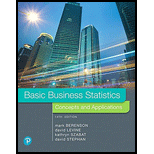
Concept explainers
A baseball analyst would like to study various team statistic for a recent season to determine which variables might be useful to predicting the number of winds achieved by teams during the season. He begins by using a team’s earned run average (ERA), a measure of pitching performance, to predict the number of wins. He collects the team ERA and team wins for each of the 30 Major League Baseball teams and stores these data in Baseball. (Hint: First determine which are the independent and dependent variables.)
a. Assuming a linear relationship, use the least-squares method to compute the regression coefficient
b. Interpret the meaning of
c. Use the prediction line developed in (a) to predict the
d. Compute the coefficient of determination,
e. Perform a residual analysis on your results and determine the adequacy of the fit of the model.
f. At the 0.05 level of significance, is there evidence of a linear relationship between the number of wins and the ERA?
g. Construct a
h. Construct a
i. Construct a
j. The 30 teams constitute a population. In order to use statistical inference, as in (f) through (i), the data must be assumed to represent a random sample. What “population� would this sample be drawing conclusions about?
k. What other independent variables might you consider for inclusion in the model?
l. What conclusions can you reach concerning the relationship between ERA And wins?
Want to see the full answer?
Check out a sample textbook solution
Chapter 13 Solutions
EBK BASIC BUSINESS STATISTICS
- (c) Utilize Fubini's Theorem to demonstrate that E(X)= = (1- F(x))dx.arrow_forward(c) Describe the positive and negative parts of a random variable. How is the integral defined for a general random variable using these components?arrow_forward26. (a) Provide an example where X, X but E(X,) does not converge to E(X).arrow_forward
- (b) Demonstrate that if X and Y are independent, then it follows that E(XY) E(X)E(Y);arrow_forward(d) Under what conditions do we say that a random variable X is integrable, specifically when (i) X is a non-negative random variable and (ii) when X is a general random variable?arrow_forward29. State the Borel-Cantelli Lemmas without proof. What is the primary distinction between Lemma 1 and Lemma 2?arrow_forward
 Glencoe Algebra 1, Student Edition, 9780079039897...AlgebraISBN:9780079039897Author:CarterPublisher:McGraw Hill
Glencoe Algebra 1, Student Edition, 9780079039897...AlgebraISBN:9780079039897Author:CarterPublisher:McGraw Hill Holt Mcdougal Larson Pre-algebra: Student Edition...AlgebraISBN:9780547587776Author:HOLT MCDOUGALPublisher:HOLT MCDOUGAL
Holt Mcdougal Larson Pre-algebra: Student Edition...AlgebraISBN:9780547587776Author:HOLT MCDOUGALPublisher:HOLT MCDOUGAL Big Ideas Math A Bridge To Success Algebra 1: Stu...AlgebraISBN:9781680331141Author:HOUGHTON MIFFLIN HARCOURTPublisher:Houghton Mifflin Harcourt
Big Ideas Math A Bridge To Success Algebra 1: Stu...AlgebraISBN:9781680331141Author:HOUGHTON MIFFLIN HARCOURTPublisher:Houghton Mifflin Harcourt Functions and Change: A Modeling Approach to Coll...AlgebraISBN:9781337111348Author:Bruce Crauder, Benny Evans, Alan NoellPublisher:Cengage Learning
Functions and Change: A Modeling Approach to Coll...AlgebraISBN:9781337111348Author:Bruce Crauder, Benny Evans, Alan NoellPublisher:Cengage Learning College Algebra (MindTap Course List)AlgebraISBN:9781305652231Author:R. David Gustafson, Jeff HughesPublisher:Cengage Learning
College Algebra (MindTap Course List)AlgebraISBN:9781305652231Author:R. David Gustafson, Jeff HughesPublisher:Cengage Learning




